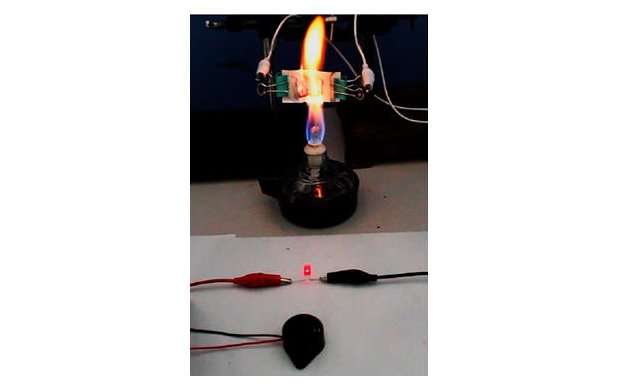

Fire-resistant wallpaper withstands flames, while a thermosensitive sensor triggers an alarm of sound and light. Credit: Chen et al. ?2018 American Chemical Society
Researchers have designed a "fire alarm wallpaper" made of environmentally friendly, nonflammable materials—including some of the materials found in bone, teeth, and hormones—that can detect a fire, prevent the fire from spreading, and give off an alarm when a fire occurs. When exposed to heat, the wallpaper is transformed from an electrically insulating state into an electrically conductive one, causing it to automatically trigger an alarm that generates loud sounds and warning lights.
The researchers, led by Professor Ying-Jie Zhu at the Shanghai Institute of Ceramics, Chinese Academy of Sciences, have published a paper on the fire alarm wallpaper in a recent issue of ACS Nano.
Most of today's commercial wallpaper is made of highly flammable materials, such as plant cellulose fibers or synthetic polymers. Consequently, whenever a fire occurs, the wallpaper often causes the fire to spread.
"Compared with flammable commercial wallpaper, the fire-resistant wallpaper is superior owing to its excellent nonflammability, high-temperature resistance, and automatic fire alarm function," Zhu told Phys.org. "The fire-resistant wallpaper has a white color, mechanical robustness, and high flexibility, it can be processed into various shapes, dyed with different colors, and printed with a commercial printer. Therefore, the fire alarm fire-resistant wallpaper has promising applications in high-safety interior decoration to save human lives and reduce the loss of property in a fire disaster."
The new wallpaper is based on hydroxyapatite, which is the primary inorganic component of bone and teeth. Although hydroxyapatite is typically brittle and inflexible, in previous work the researchers found that forming ultralong nanowires made of hydroxyapatite gives the material a high flexibility suitable for making wallpaper.
In order to make the nonflammable wallpaper a "smart material" capable of automatically sounding an alarm in response to a fire, the researchers incorporated an ink-based thermosensitive sensor onto the wallpaper.
Credit: Chen et al. ?2018 American Chemical Society
The thermosensitive sensor is fabricated on the surface of the wallpaper by a simple drop-casting process using an ink containing graphene oxide. The tiny sensor is placed on the backside of the fire- resistant wallpaper so that it is out of sight and protected by the fireproof wallpaper.
The sensor is composed primarily of graphene oxide, which is electrically insulating at room temperature. However, when exposed to heat, the oxygen-containing groups are removed, making the material highly conductive. The sensor is connected to an alarm, so when a fire occurs and the sensor begins to conduct electricity, it causes the alarm to go off.
Initially, one problem with the graphene oxide sensor was that it burned out very quickly, so that the alarm only lasted for about three seconds. To improve this, the researchers modified the graphene oxide with polydopamine—a material based on the hormone and neurotransmitter dopamine, found in living organisms. The polydopamine-modified graphene oxide has a much lower thermal responsive temperature than graphene oxide by itself, meaning that it not only responds to fire more quickly (in about two seconds), but also has a prolonged alarm time of more than five minutes.
In the future, the researchers plan to scale up production of the wallpaper, as well as investigate other applications of the new fire-resistant material.
"The mass production of ultralong hydroxyapatite nanowires as the raw material for the smart fire alarm fire-resistant wallpaper is critical," Zhu said. "To date, we have realized the scaled-up production of ultralong hydroxyapatite nanowires in an autoclave with a volume of 100 liters in our laboratory. We are striving to explore the low-cost and environmentally friendly large-scale production technology for ultralong hydroxyapatite nanowires. In addition, many companies are interested in the new kind of the fire-resistant paper, and we will collaborate with some companies to realize industrial-scale production in the future.
"We have also been exploring various applications of the new kind of fire-resistant paper based on ultralong hydroxyapatite nanowires in many other fields, such as preserving important paper documents, energy, air purification, water treatment, environment protection, anti-counterfeiting, flexible electronics, and biomedical uses." (Phys.org)

86-10-68597521 (day)
86-10-68597289 (night)

52 Sanlihe Rd., Xicheng District,
Beijing, China (100864)

